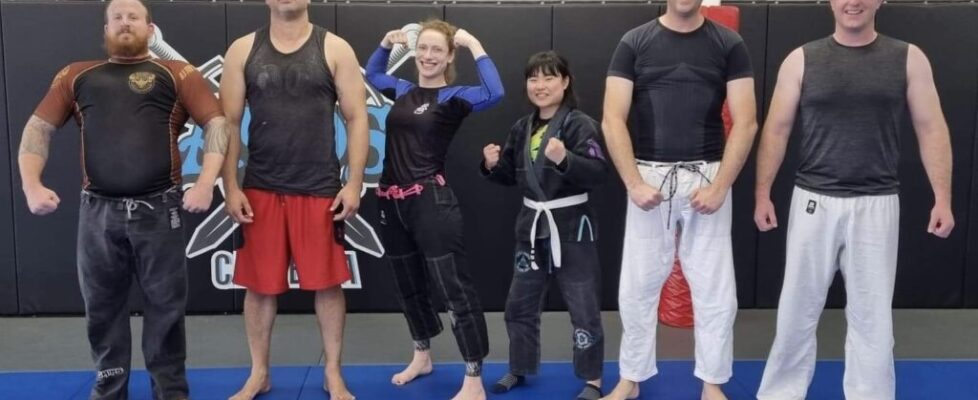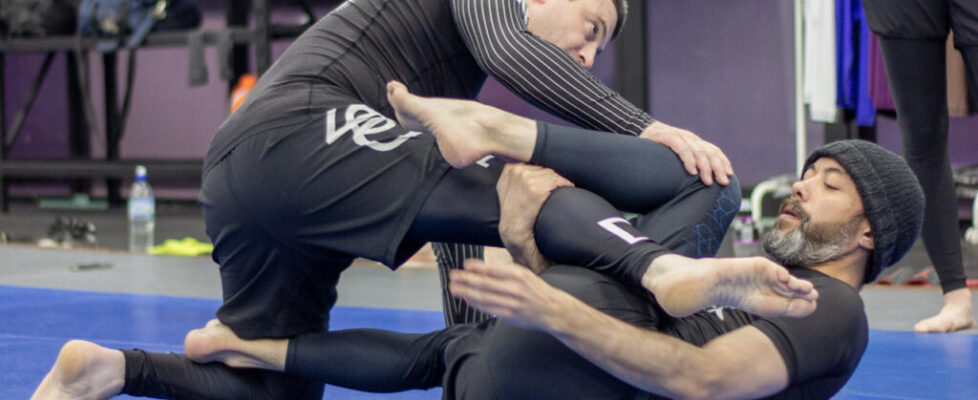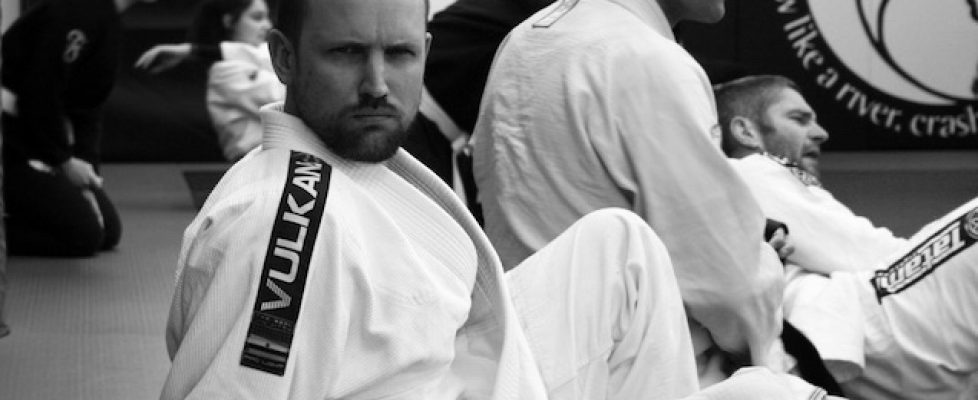
Stretching For BJJ: Develop Black Belt Flexibility
Basic Programming
######










“Breathe. Just Breathe.” – Jedi Master Luke Skywalker
This is probably one of the most commonly misunderstood concepts in martial arts so let’s just start with a bit of science to help us talk about it sensibly.
First – I don’t care what your mum, Kron Gracie or the yoga instructor with the pretty eyes told you it is physically impossible to further oxygenate your body. Blood oxygen levels typically sit at 95 to 100% and your breath can only affect this minimally. Breathing is more about maintaining the balance between oxygen being taken into your body and the carbon dioxide being expelled.
Most people assume that low levels of oxygen trigger the urge to inhale. Instead, it is the concentration of carbon dioxide in the bloodstream that brings on the desire to breathe. Everyone has a certain level of carbon dioxide in their blood; it is a product of normal oxygen metabolism. However, unlike blood oxygen levels, carbon dioxide concentration is controlled by the frequency and intensity of breathing.
As a result, the feeling of being “out of breath” is less about you needing to take more oxygen in and is more about needing to get more carbon dioxide out.
When you exercise your body will begin to breath harder and faster in an effort to maintain the balance between the concentration of oxygen and carbon dioxide. Unfortunately, inefficient breathing patterns where the exhale is cut short – and attempts to “take a deep breath in” – undermine this process leading to a situation where an otherwise fit athlete fatigues and potentially even panics.
One of the easier ways to overcome this issue is to adopt and develop specific breathing techniques while you train. While the following strategies are described with the Jiu Jitsu practitioner in mind the concepts and principles are easily adaptable.
Exhale and Centre
This breathing technique is by far the simplest and can be integrated into your training immediately with surprisingly effective results.
You ready for it?
Take a deep breath out.
Seriously.
Anytime that you catch yourself feeling tired, stressed or panicky focus on making a long exhalation before resuming. This has the dual benefit of bringing your breathing under control in a way which directly addresses the imbalance of oxygen and carbon dioxide in your system and re-centring yourself in the moment.
While this method is easy to implement, and can be used in conjunction with the other methods listed in this article, it unfortunately treats the symptoms of inefficient breathing rather than addressing the cause. It is also a massive signal to your opponent that you were just feeling tired, stressed or panicky.
Percussive Breathing
Most commonly exemplified by the Gracie family this method involves taking a normal inhalation followed by two or three short, sharp exhalations while contracting your diaphragm.
“Tss… Tss… Tss” – Rickson Gracie
The main benefit of this approach is the unchanging nature of the breathing pattern itself – you don’t speed up when you get excited or stressed and you won’t unconsciously start holding your breath during tense moments.
The downside is that I’ve found that this style of breathing initially takes a fair degree concentration so it’s difficult for someone who is not already very technically competent to implement.
Match your Breath to the Extension and Flexion of the Hips
When you breath in the air pressure in your lungs increases and exerts force against the anterior of your spine which results in a more rigid torso and when your breath out this same pressure decreases allowing for a more relaxed and pliable torso.
As Roger Gracie Blackbelt, Nic Gregoriades, notes “In Jiu Jitsu the movements which require the most strength -like bridging under mount – are usually those which involve hip extension and a rigid torso and those which require the greatest relaxation -like getting stacked during a guard pass – are those where your hips and spine go into flexion. If we match our breathing to these motions we can increase our strength or relaxation in the most efficient way possible.” (edited for brevity)
Anytime the distance between your shoulders and your toes decreases breath out.
Anytime the distance between your shoulders and your toes increases you should breath in.
Practice this during your warm up, any kind of solo work and eventually during drilling with a partner and in will become an ingrained part of your movement patterns.
******
It’s also worth considering that your mental state and your breath are inexorably linked. Some simple breathing exercises can have a profound effect on your state of mind and improve the quality of your Jiu Jitsu practice if you make them a part of your regular routine.
You have to let it all go. Fear, doubt, and disbelief. Free your mind. ” – Morpheus
Solo Breathing Drills
Never ever, ever perform any kind of breath control practice in or near a body of water. Seriously – this is an easy and depressingly common way to die. Performing them while standing on a ladder or leaning over a display of knives is also highly discouraged.
Bellows Breathing
To practice either kneel or sit cross legged on the floor with your palms on your knees and a straight back. Do not perform bellows breathing sitting in a chair as this breathing exercise is the one most likely to cause you to faint if you over do it.
Inhale and exhale rapidly through your nose, keeping your mouth closed but relaxed. Your breaths in and out should be equal in duration, but as short as possible. This is a noisy breathing exercise.
Try for three in-and-out breath cycles per second. This produces a quick movement of the diaphragm, suggesting a bellows. Breathe normally after each cycle.
Do not do for more than 15 seconds on your first try. Each time you practice Bellows Breathing you can increase your time by five seconds or so until you reach a full minute.
4:7:8 Breathing
Place the tip of your tongue against the ridge of tissue just behind your upper front teeth and keep it there through the entire exercise. Relax your throat. You will be exhaling through your mouth around your tongue.
Exhale completely through your mouth allowing your throat to make a light whoosh sound.
Close your mouth and inhale quietly through your nose to a mental count of four.
Hold your breath for a count of seven.
Exhale completely through your mouth, making a whoosh sound to a count of eight.
This is one breath. Now inhale again and repeat the cycle three more times for a total of four breaths.
Note that with this breathing technique, you always inhale quietly through your nose and exhale audibly through your mouth. The tip of your tongue stays in position the whole time. Exhalation takes twice as long as inhalation.
“If the mind is the kite then the breath is the string.” – I can’t remember
Box Breathing
Close your eyes. Breathe in through your nose while counting to four slowly. Feel the air enter your lungs.
Hold your breath inside while counting slowly to four. Try not to clamp your mouth or nose shut. Simply avoid inhaling or exhaling for 4 seconds.
Begin to slowly exhale for 4 seconds.
Hold your breath out while counting slowly to four. Again, try not to clamp your mouth or nose shut. Avoid inhaling or exhaling for 4 seconds.
Repeat steps 1 to 3 at least three times. Ideally, repeat the three steps for 4 minutes.

Correct the technique of higher ranked, more experienced people than yourself.
They love it and will view you with respect and awe.
Never wash your rash guard or gi.
Just keep it in your car or balled up in your bag. If someone complains they clearly don’t understand the #bjjlifestyle.
Don’t pay any attention to what is being taught.
If you haven’t seen it before it’s definitely bullshit. If you have seen it before you already know it and it’s not worth your attention.
When your partner is practicing a new technique counter it every time to show them they are doing it wrong.
This way they will know that you are definitely better than them and they will appreciate the constructive feedback.
Always roll like you’re in the final of the Mundials.
If you’re not practicing winning, you’re practicing losing.
Attempt nothing.
Just hug your partner and perform a 300 second isometric squeeze. If you don’t attempt to do jiu jitsu you can’t fail at doing jiu jitsu.
About to lose? Start coaching or fake an injury.
You haven’t really been submitted if you stopped trying.
Either don’t trim your nails or trim them right before class to ensure that they are razor sharp.
If your training partner has to leave the mat to make sure they don’t bleed out from the thousands of cuts you just inflicted that stills counts as victory.
Always brag about the submissions you got in training to other class members.
Re-live your favourites with anyone nearby. Your past submissions are like MASH reruns – no one ever gets sick of them.
If you compete in a tournament and lose be sure that everyone understands that the problem wasn’t your poor work ethic, your low level of fitness or your complete lack of technique – it that you (select all that are appropriate):
Were sick
Haven’t slept well all week
Didn’t eat before the match
Ate too much before the match
Had a BYE the first round
Had an opponent who had a BYE the first round
Lost to the guy who won the division
Were robbed by the ref
Had an injury
Lost to a sandbagger
Faced an opponent who was on steroids
Didn’t have enough time
Got DQ’d for some bullshit
Lost by a bullshit advantage
Faced an opponent who just stalled
Were tired from traveling
Just remember that you don’t need to do better; you just need to convince yourself – and everybody else – that you already have.*
Explain how if this was a no gi match you totally would have won.
Explain how if this was a gi match you totally would have won.
Explain how if this was an MMA match you totally would have won.
Exclusively go for techniques you are not allowed to do.
Neck cranks, finger locks and nipple cripples should be your go to moves. BJJ is a martial art for the street and you refuse to water down its effectiveness.
Ask for advice from your coaches and training partners about a problem you are having. Explain to them how it’s not actually a problem and why you are not going to follow that advice.
That way they will know that even your problems are actually successes they don’t understand.
Beat the hell out of new guys.
This will show them the power of BJJ and guarantee they come back.
If you are tired wait until you are losing to stop.
You shouldn’t give your training partner a false sense of success by letting them tap you just because you are tired from all the winning you have been doing. Instead stop rolling and the moment you end up in an inferior position you can’t easily escape from and explain that you are not unfit – you’re just recovering from a max deadlift attempt and the three different Crossfit WODS you considered doing earlier that day.
Don’t tap.
If your training partner let’s go to make sure that you don’t get hurt then the submission wasn’t really on. If you get hurt then they are being way too reckless and there’s no way they could have got you if you had been going as hard as they were.
Always use extra force and power when rolling with anyone smaller and weaker than you.
They will appreciate the respect you show them by not holding back and be encouraged to get better. Whenever you roll someone bigger or better than yourself complain that they are too rough.
Before rolling explain you have an injury and want to go light.
After they agree roll lightly for ten seconds before surprising them by attacking with 100% speed and power. This will definitely impress anyone watching.
*credit to a Josh Hinger rant for inspiring this one.

See to it that you temper yourself with one thousand days of practice, and refine yourself with ten thousand days of training.
– Miyamoto Musashi
Your sport or art should obviously be the primary component of these six practices. The key here is to understand that your athletic practice is the most important aspect of all your training. If you are interested in being a legitimate athlete then focus is genuinely required.
To quote coach extraordinaire, Dan John, “The goal is to keep the goal, the goal.”
If you have an element of your training or lifestyle that is interfering with your ability to train or perform your sport or art you have to decide what your focus is going to be.
You should be training or performing in your athletic practice 4 to 6 days a week.
Strength and Power Practice
The poor implementation of a strength and power practice is by far the largest and most common impediment in an athletes development.
Too many people consider the barbell a test of mettle rather than as a tool of training.
The goal of this practice is to become strong and powerful for the kind of athlete that you are and not in some kind of general or absolute sense. This means that roller derby skaters need to be strong compared to other skaters but not necessarily when compared to powerlifters or gymnasts.
The bottom line is that what you do in this practice should support – not hamper – what you do on the mat, field, track or ring.
Ideally your strength and power practice should be overseen by a knowledgeable and experienced strength coach. If a personal coach is not an option for you I recommend researching Jim Wendler’s 5/3/1 program or Pavel Tsatsouline’s Power to the People program.
You should be implementing your strength and power practice 2 to 5 days a week.
Nutrition Practice
People often act like proper nutrition is some kind of complicated black magic or quantum level science but unless you have a severe or rare metabolic disease nutrition can be boiled down to two simple rules.
1. Eat like a fucking adult.
2. Don’t kid yourself.
If you can do this you are already out performing 90% of the population.
Eat like a fucking adult.
Eat food.
Eat real food.
Real food doesn’t come out of a can, or a box or a bag. Real food goes off.
No one over the age of 12 really thinks that nutri grain is ironman food or that diet coke is a healthy choice.
Eat vegetables for health.
Eat meat for strength.
Eat carbs for recovery.
Don’t kid yourself.
You know that pizza and beer aren’t getting you closer to your goals.
And the problem is not that you should *never* consume pizza and beer. The problem is that you pretend that because you ordered a gluten free base and low carb beer that you are somehow still eating well when what you actually did was fuck up a perfectly good meal.
Movement Practice
Repeated movement patterns take a toll and the more specific and intense your athletic practice the more specific and intense stress is placed upon your body.
If longevity in your sport and maintaining a pain free day to day life are among your goals (and they should be) then these issues should be addressed by maintaining a movement practice as a part of your schedule.
Stretch what is too tight, open what is too closed and stabilise what is too loose. This can be as simple as going through a mobility routine – like DeFranco’s Agile 8 – three or four times a week or beginning a full blown yoga practice.
Meditation Practice
A meditation practice is an incredibly powerful tool for improving all areas of your life especially your athletic performance.
We’ve all had those experiences of getting into the “zone” or hitting our “flow”. Matches or performances where time seems to slow down and our ability to think, move and react seems limitless. We recognise the advantage of this state but hardly anyone actually trains to deliberately enter into it.
As athletes we are obsessed with training our bodies but so few of us put the effort in to train our minds.
The “zone” is really nothing more than consistent mindfulness. The ability to remain in and focus on the present moment without distraction.
Regular meditative practices cause actual structural changes in the brain. Just ten minutes a day can improve your will power and decision making capabilities; increase your focus and decrease your stress.
Ten minutes a day, everyday.
Developing a meditation practice doesn’t necessarily mean that you’ll end up sitting in the lotus position, wearing flowers and talking in the breathy, hushed tones of someone who just finished a three day yoga instructor course.
To get started try the Headspace app, google ‘daily journaling’ or click here.
Lifestyle Practice
Your lifestyle practice is primarily about making sure you stay physically, mentally and emotionally healthy. By necessity training environments tend to be fairly insular and it’s easy to fall into the pattern of eat, sleep, train, repeat. While this makes for some neat tee shirts the reality is that it’s an expressway to injury and burnout.
The specifics of a happy and healthy lifestyle are unique to each person but there are few general principles that will always apply.
Get enough good quality sleep.
Have interests outside your athletic practice.
Spend time with people.
Spend time by yourself.
Spend time simply playing.